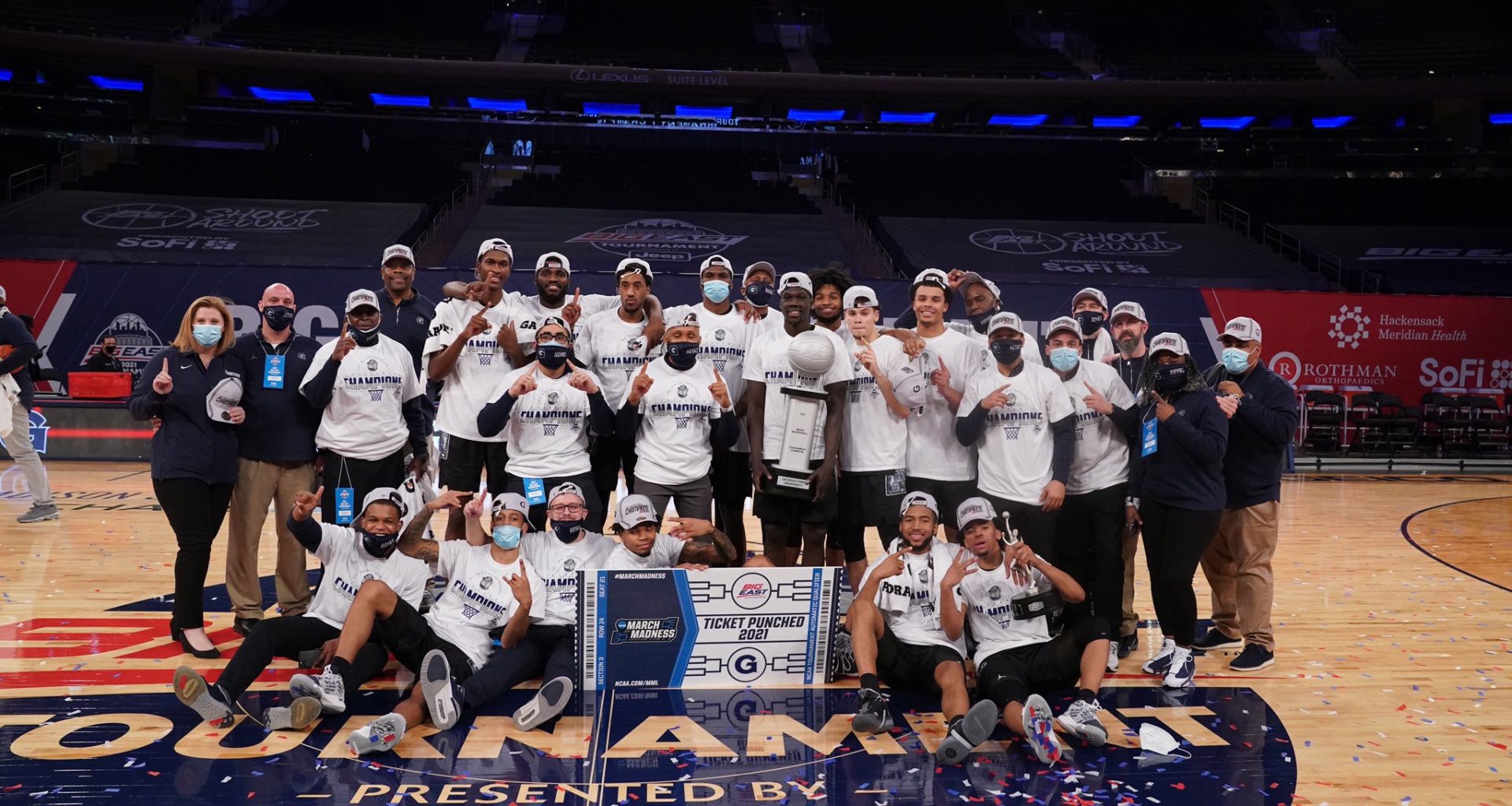Though September may typically feel like a dead period in the college basketball calendar, recent conference realignment news has exploded in the last couple of weeks. Though predominantly driven by football, these recent shifts should prompt us to reconsider Georgetown and the Big East’s status in the college basketball community. I think many of the conversations Hoya fans have been having regarding conference membership, scheduling, and potential member editions need to be discussed together.
Recent Realignment and Alliances
Massive conference realignment has returned for the first time since the 2013 reshuffling. Oklahoma and Texas did their very best to send the power conferences into a frenzy by joining the SEC by 2025 at the latest. As the dust (hopefully) begins to settle, the Big 12 has formally extended invitations to BYU, Cincinnati, Houston, and UCF. While at first it appeared that the Big 12 may implode entirely, this development seems to suggest that the conference will have just enough glue to survive the Oklahoma/Texas exodus.
Naturally, many Big East fans are much happier standing and watching this drama from the sidelines, rather than having to relive the conference’s own exodus of 2013. Fortunately, the state of the conference appears extremely stable. The identity of the Big East as a basketball-only league has ensured that not a single team has sought greener pastures since 2013. UConn made the wise move to go independent in football and come back home last season, evidence that the Big East still holds pull in the college basketball world. Unless UConn football makes a miraculous revival, there is no need to fear that any of the current members would consider jumping ship. There simply is no better non-football conference than the Big East.
Things are not all entirely rosy for the Big East, though. The looming discussion of super-conferences and the recent announcement of the ACC/Big Ten/Pac-12 scheduling alliance in both football AND basketball suggests that the Big East may need to make some moves in order to maintain its status as a premier college basketball conference. There has even been speculation that the Power 5 conferences could secede entirely from the NCAA and form their own athletic association (at least in football).
It is entirely reasonable for Big East fans to be wary of expansion. Big East fans did not have a great time in 2013, to put it lightly. However, the conference has bounced back well, and it remains extremely relevant. At worst, it’s the best basketball league outside of the Power 5. In its current state, the Big East remains small but mighty, as it has sent at least four of the 11 member teams to the NCAA tournament every year since the 2013 realignment (thanks in part to Georgetown’s magical 2021 Big East Tournament Championship run).
Scheduling
Still, the conference must remain actively open to the possibility of adding new members, especially as the other power conferences continue to grow. Both the Big East-Big 12 Battle and the Gavitt Tipoff Games (the Big East/Big Ten scheduling alliance) expire in 2022. The potential loss of these alliances threatens to leave the Big East as the “power” basketball conference left out. We also saw the ACC move from an 18 game to a 20 game regular season schedule, threatening the future of the Georgetown-Syracuse series (especially given Jim Boeheim’s age). The early season tournaments are further eating up several games in each team’s schedule, making it extremely hard for Big East schools (other than Villanova) to sign meaningful home-and-home series. The Hoyas recently inked a moderately exciting series with South Carolina, but most agreements besides Syracuse in recent memory have been duds. Not many fans were impressed with the recent SMU home-and-home series, and these match-ups neither help NET rankings nor generate general excitement.
Obviously, the scheduling issue seems dire. There is one potential solution that requires acknowledgment. Some fans and commentators (what’s up Bobby Bancroft) have thrown around the idea of heavier DMV scheduling, and there is good reason to hear this concept out. They argue that Georgetown would do well in scheduling local schools such as Maryland, George Washington, George Mason, American, and Howard. Ewing has in fact scheduled Howard and American in recent years, but the stronger programs—Maryland, George Washington, and George Mason—have been avoided like the plague. The most recent Georgetown-Maryland home-and-home expired in 2017, Georgetown has not played George Washington since 1981, and there has only been one Georgetown/George Mason contest ever! Fairly, fans note that these middle-tier local games could threaten local recruiting if the Hoyas were to get upset and thus lose their status as the best college basketball program in the DMV (or at least within District limits). Yet, Philadelphia does perfectly well with their “Big 5” annual scheduling alliance between Villanova/Penn/La Salle/Temple/St. Joseph’s. You don’t hear Villanova complaining about those series each year. Can the same not be replicated in the DMV?
In my opinion, the answer is clearly no. Villanova simply lives in a different stratosphere than the rest of the Philly area teams. They have won the tournament six of the last seven years and are at no risk of being leap-frogged by any of those programs. Georgetown, on the other hand, may be on the rise but has not yet reached this elite status. Furthermore, Villanova can afford to play these games because they have the clout to schedule home-and-home series with premier programs like Virginia and UCLA, as they have recently done. Georgetown has been forced to lean on preseason tournaments and conference scheduling alliances for its matchups before Big East play, and those opportunities are quickly drying up.
The Necessity of Big East Expansion
I bring up this whole scheduling conversation because it is my belief that as super conferences continue to grow up to 16 teams, the non-conference schedule will become less and less important in the future. For one, teams will continue adding more conference games to feed their TV contract providers, so the length of the non-conference will shrink. Furthermore, the Big East will potentially be left out of future scheduling alliances with Power 5 conferences, thus limiting their pickings for quality opponents. These long-term problems require a long-term solution that will send chills down Big East fans’ spines: expansion.
Expansion does not need to all happen right now. However, Oklahoma and Texas have undoubtedly triggered at least a minor domino effect which the Big East ought to take advantage of. Programs are more keen on hopping conferences than they would have been three years ago. Big East Commissioner Val Ackerman must put serious thought into growing the league or risk getting squeezed out from the national conversation as the Power 5 continues expanding.
Yes, there is something aesthetically pleasing and convenient about the current Big East scheduling format where each team plays a home-and-home against every other team, but even a 20 game league schedule may become too small in the future. I firmly believe that the only way for the Big East to maintain its status as a premier basketball conference in the future is to pursue expansion. With that being said, let’s check out the options.
In my opinion, adding Kansas is a dream scenario. With the Big 12 reshuffling, Kansas is in a very unique position. Their football program remains abysmal, having not won more than three games in a season since 2009. I mean come on, the fans recently rushed the field after the Jayhawks beat FCS opponent Montana for their first win since 2019. This is a perennial blue blood basketball school and a pitiful football program. If rumors are true that the Big Ten is not interested in bringing them in, their fit in the Big 12 looks less than ideal for football, as they have little hope in ever rising to relevance in the conference.
Still, the Big 12 was the second-best basketball conference last year according to Kenpom, and Houston, Cincinnati, BYU, and UCF are all quality basketball programs as well. To say that Kansas is in the same boat as UConn was would be a false equivalence. UConn sucked at football AND was in a rough basketball conference. Unlike UConn, Kansas isn’t stuck playing games on ESPN+, and the Jayhawks are already playing against quality basketball opponents. Despite my deepest wishes, I highly doubt that Kansas gives more than a glance at the Big East, though it has been fun watching Villanova fans quiver at the idea that they would no longer run the conference if Kansas hopped on board.
There is another option in the Sunflower State with real potential: Wichita State. Here the clear question seems to become: Would the Big East want to add the Shockers? I think at a minimum there needs to be serious conversation. The basketball-only member of the American has not finished below 68 in KenPom since 2009. They won the American regular season championship last year and have made the NCAA tournament five times since realignment in 2013. Their average home game attendance in 2019 was 10,194—higher than every Big East program except for Creighton and Marquette. And, while some may say that Kansas does not make enough geographical sense to add to the Big East, let me remind you that Omaha, Milwaukee, and Indianapolis are all Big East cities. Wichita State also checks the biggest box of all—they do not have a football program that could threaten their long-term membership in the conference. Furthermore, they would not overlap in a currently represented Big East metropolitan area. Besides concerns about basketball fortitude, there are only two reasons for the Big East to be skeptical of adding Wichita State.
The first reason Wichita State may not happen is that they just recently joined the American in 2017. It may be hard for the administration to justify jumping conferences after just 5 years. The second and more pressing issue is the recent firing of Gregg Marshall. Despite having been the winningest coach in Shocker history, allegations of physical and verbal abuse forced his resignation in 2020. Without this development, I believe it would have been much more likely that the Big East would have already extended an invitation to Wichita State. Nonetheless, Wichita State is the program that makes the most sense to invite to the Big East Conference right now and should be sent an invitation. A recent poll by a very high-quality Georgetown basketball Twitter account that you should follow right this second recently confirmed that a slight majority of Georgetown/Big East fans would favor the move as well.
Before you ask, I realize that this article leaves out the potential additions of any of the A-10 schools (including VCU, Davidson, Saint Louis, Rhode Island, and Fordham). Currently, the A-10 just feels too much like a smaller, weaker version of the Big East for any of these teams to make sense as a Big East program. They could be a useful filler league in the future, but there are not currently any stand-out programs that would be worth scooping up.
If you made it this far, thank you for surviving this winding narrative of realignment, scheduling concerns, and the future of Big East expansion. Too often, I believe that these subjects are discussed separately despite the fact that they are wholly intertwined issues.
Please feel free to comment with your perspectives on the future of Hoyas and the Big East!
Hoya Saxa!








